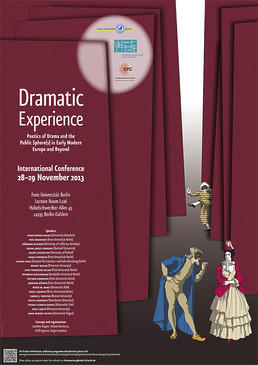DramaNet Konferenz
Dramatic Experience: Poetics of Drama and the Public Sphere(s) in Early Modern Europe and Beyond
From Aristotle to New Historicism, drama has been recognized as a medium tailored to produce and manipulate collective emotions, whether anthropologically constant or socially and historically variable. This conference is designed to investigate different approaches and venues of research open to students of early modern drama, departing from this understanding of drama. Bringing together experts on Western European cultures, as well as scholars working on Russia, East Asia and Northern Africa, we intend to explore the interaction between “universal”, internationally transferable theatrical poetics, textual genres and performative techniques, and specific audiences, diverging socially, geographically and chronologically. Reaching beyond theater studies per se, this perspective will allow us to address the complex structure of various early modern “public spheres”, from the court society to various forms of lower class sociability, as well as the issue of public emotionality and its place in cultural history: the differences and similarities in form and function between theater and ritual, the importance of theatrical practices for pre-modern social and political order, the tensions between public and private, social and aesthetic sensibilities
It is one of the premises of the DramaNet project that the internationally spread early modern European theater constituted the first mass medium in human history. This assumption implies that aesthetic effects and techniques of fiction were aligned with, if not steered by, a social logic of mass consumption that consistently allowed theaters to attract heterogeneous audiences usually divided by geographical and social distance. According to this perspective, drama constitutes a rich set of techniques specifically elaborated to retain and manipulate the emotional community it creates, along with a certain symbolic logic. In his Poetics, which has since its rediscovery in the Renaissance constituted the basis for European dramatic theory, Aristotle argued that tragedy aroused “passions” in order to “purge” or “purify” them, thus disciplining individual emotionality according to a collectively accepted social ideal. The endless variety of interpretations that this authoritative yet enigmatic doctrine produced in early modern times is symptomatic of the complexity of issues that concern the performative practices known to us as “theater” and “drama”.
These general issues have to be addressed with an eye for the diversity and ambivalence of theatrical practices characteristic of early modern theater, its authors, actors and audiences. Between humanist revivals of Graeco-Roman dramatic heritage and local customary drama, between scripted commedia erudita and the improvisational commedia dell’arte, secluded court stages and multilingual performances of itinerant companies accessible to large and diverse audiences, between amateurs and professionals, ritualized festivities and commercial enterprises, the medium of theater drew upon a wide range of genres and techniques of enticement, which constantly defied taxonomies and delimitations imposed on them by the current social and aesthetic normative protocols. In theory, the hierarchy of theatrical genres and styles was realigned with the social hierarchies and the outlines of current political order, which had to be reaffirmed and re-enhanced through its means. In practice, theater created a largely autonomous space of collective sensibility, a “public sphere” in its own right, where the emotional, social and political experience of the audience was shaped and explored in ways hardly controlled by any authority, theatrical or political.
Possible topics and questions include but are not restricted to the following:
-
Theater employs medium-specific modes of interaction with its audiences, between dramatic authorship, staging practices and public demands and reactions. What was specific about the functioning of these interactions in early modern times? How was theatrical effect understood in contemporary theoretical discourses, and how did they relate to dramatic practice? How were emotional and social effects of performance different from, or similar to, those of books and paintings?
-
How did theatrical spaces consolidate and reshape different “public spheres” either in accordance with or in contradiction to established social hierarchies? How did these social developments affect the techniques of drama and performance?
-
How did theater manipulate the audience and its emotions in order to convey certain values or visions, social, moral or aesthetic? How did on-stage role-playing affect the public view of social roles?
-
How did drama and performance relate to the political theatrics of power?
-
What strategies of enticement were employed in early modern theater? How did stage scenery and machinery manipulate the spectators’ perceptions?
-
How did theatrical techniques interact with other media during synthetic social performances, such as religious rituals, courtly fetes or social games?
-
In classical theory, both in Aristotle’s Poetics and Horace’s Ars poetica, the reaction and judgment of the audience was recognized as the ultimate measure for drama and its performances. How was the role of the theatrical audiences understood and theorized throughout the early modern age? How did it evolve in practice? How did the audience’s responses influence the production and circulation of theatrical texts?
Weitere Informationen zu den Gästen sowie das Konferenzprogramm finden Sie hier.

